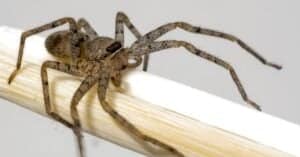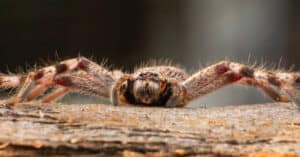Kentucky is a land famed for whiskey and horse races and boasts a historical reputation as a magnet for European adventurers seeking to expand into America’s uncharted interior. At the same time, the Bluegrass State is a land full of natural beauty that includes ancient mountains and verdant plains. In addition to scenic vistas, the state is home to many animals including opossums, moles, and white-tail deer. The state also boasts a significant number of spider species. From black widows to fishing spiders you can find many different kinds of spiders in Kentucky. Here are 10 spiders in Kentucky that are commonly found throughout the state:
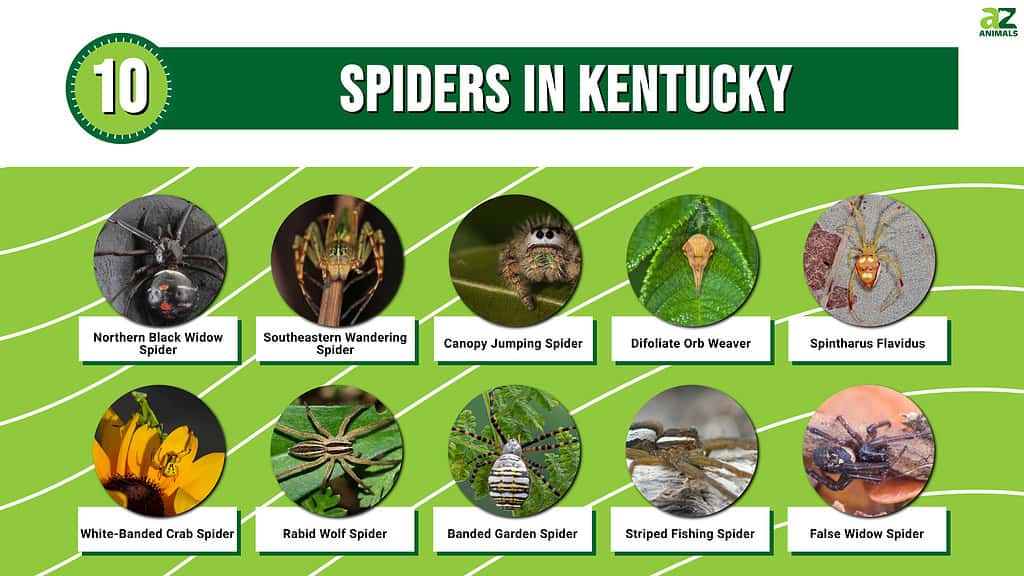
Now read on to learn more about these diverse and fascinating spiders!
#10: False Widow Spider
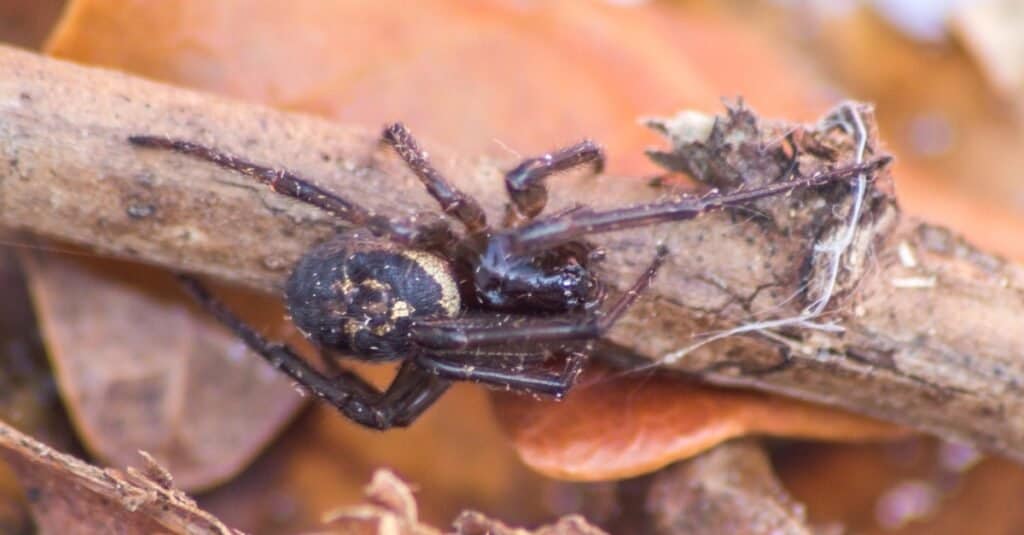
The false widow spider is thought of as being very dangerous, which could be giving the spider a bad reputation.
©iStock.com/Steve_Hardiman
Also known as the cupboard spider, the false widow spider, Steatoda grossa, is one of the most misunderstood spiders in Kentucky. It belongs to the genus Steatoda in the family Theridiidae and is widely distributed throughout North America, Australia, and Europe.
As its name implies, the false widow spider is often mistaken for the more dangerous black widow spider. Female false widow spiders measure 6 to 11 millimeters long, while males measure slightly smaller. They typically appear dark purplish-brown or black. However, unlike true widows, false widow spiders lack a red hourglass-shaped marking on their abdomens.
False widow spiders build a sticky cobweb that they use to capture prey. They have poor eyesight and therefore rely on sensing vibrations in their webs to determine if they’ve caught an insect. While their bite is medically significant, it is not nearly as deadly as the bite of a true widow.
#9: Striped Fishing Spider
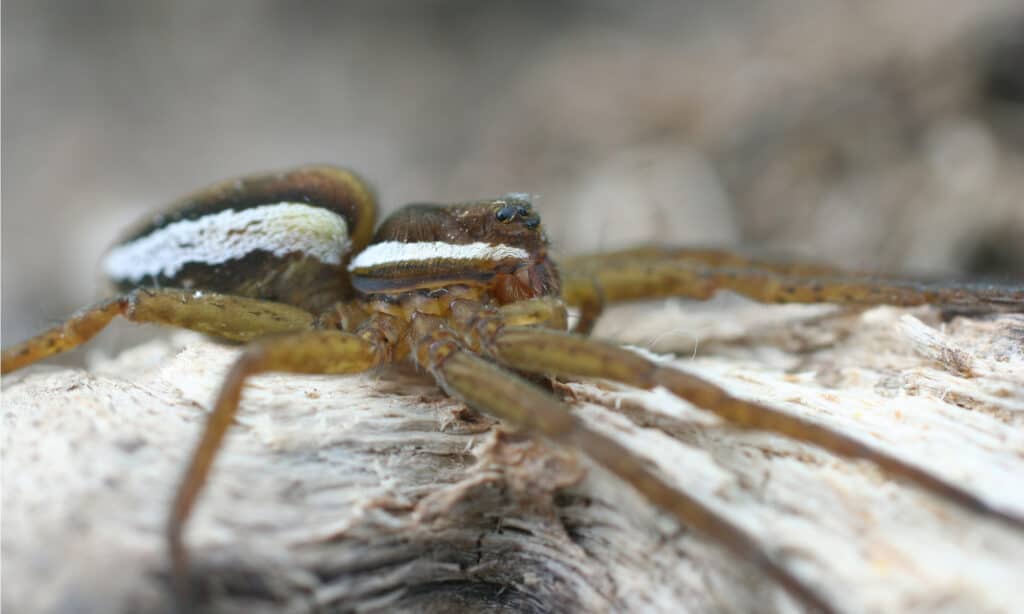
The striped fishing spider fishes for prey along fast-flowing streams and other bodies of water.
©Oleg Nikonov/Shutterstock.com
The striped fishing spider, Dolomedes scriptus, belongs to the fishing spider family Pisauridae. You can find these spiders in Kentucky as well as throughout parts of the United States and Canada.
Female striped fishing spiders can measure up to 2.5 centimeters long, while males measure smaller than females. Overall, their color is predominantly light brown but they can also appear tan or greyish. They often feature a thick white or tan stripe down each side of their bodies and dark W-shaped markings on their abdomens.
Striped fishing spiders tend to live along streams, particularly fast-flowing streams, as well as ponds and lakes. Instead of building webs to catch prey, they hunt by stretching their forelegs out over the water’s surface and ambushing prey that gets too close. They can also run across the surface of the water or dive into the water to catch insects and small fish.
#8: Banded Garden Spider
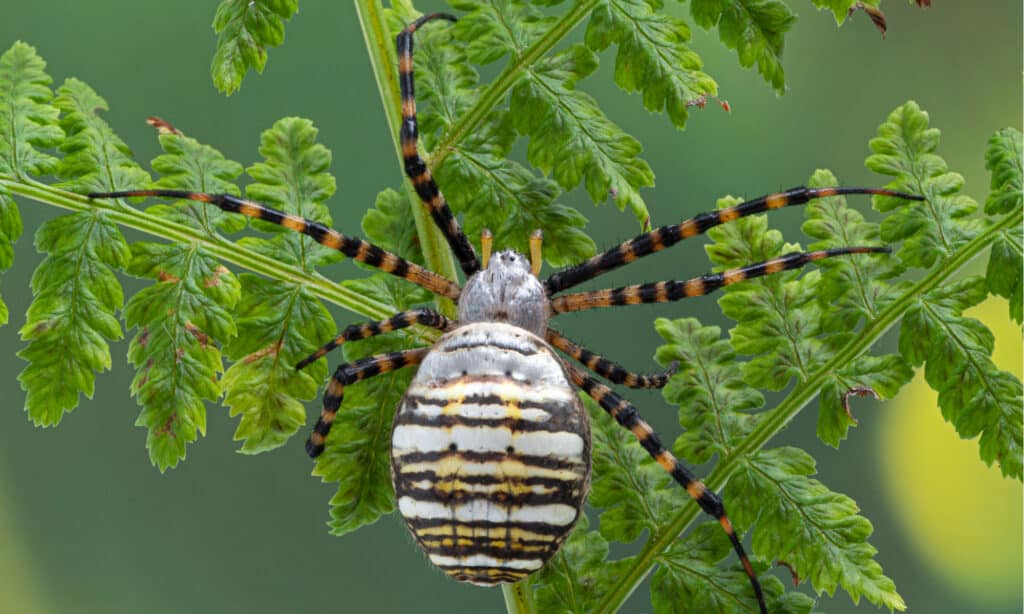
You can often find banded garden spiders with their bellies facing south, which is likely done to help with their thermoregulation.
©Ernie Cooper/Shutterstock.com
Also known as the banded orb weaving spider, the banded garden spider, Argiope trifasciata, is one of the most common spiders in Kentucky. While originally native to North and South America, you can now find these cosmopolitan spiders throughout the world.
Female banded garden spiders typically measure between 13 and 15 millimeters long, while males measure about one-third that size. Colors vary depending on the individual, but they generally feature reddish-brown and white bands or black with yellow and white bands. Their abdomens appear quite round and wide, while tiny, silvery hairs cover their carapaces.
Banded garden spiders construct spiral webs measuring around 2 feet in diameter. They sit upside-down in the center of their webs with their bellies normally facing south. Although they rarely act aggressively towards humans, their bite is moderately painful but not medically significant.
#7: Rabid Wolf Spider
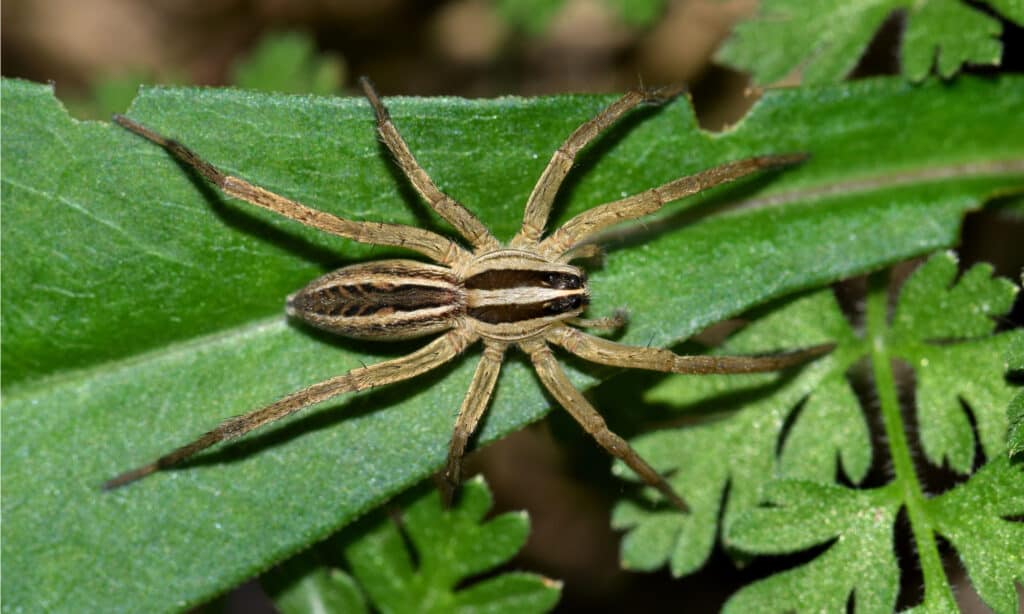
The rabid wolf spider is harmless to humans and hunts for insects during the night hours.
©Brett Hondow/Shutterstock.com
The rabid wolf spider, Rabidosa rabida, is a member of the wolf spider family Lycosidae. It is native to North America, and one of several wolf spiders in Kentucky.
Female rabid wolf spiders can measure nearly 2.5 centimeters long, while males measure about half that size. They appear predominantly yellowish-brown and have long legs. Their cephalothorax features two thin dark brown stripes, while their abdomens sport one thick dark stripe.
The rabid wolf spider gets its name from its jerky, frantic movements that make it look as if it’s rabid. It does not build a web to catch prey and instead relies on its speed, strength, and the element of surprise to catch insects. Despite its intimidating name and its appearance, it is not usually aggressive. That said, its bite can be painful and some redness and swelling, but is not otherwise medically significant.
#6: White-Banded Crab Spider
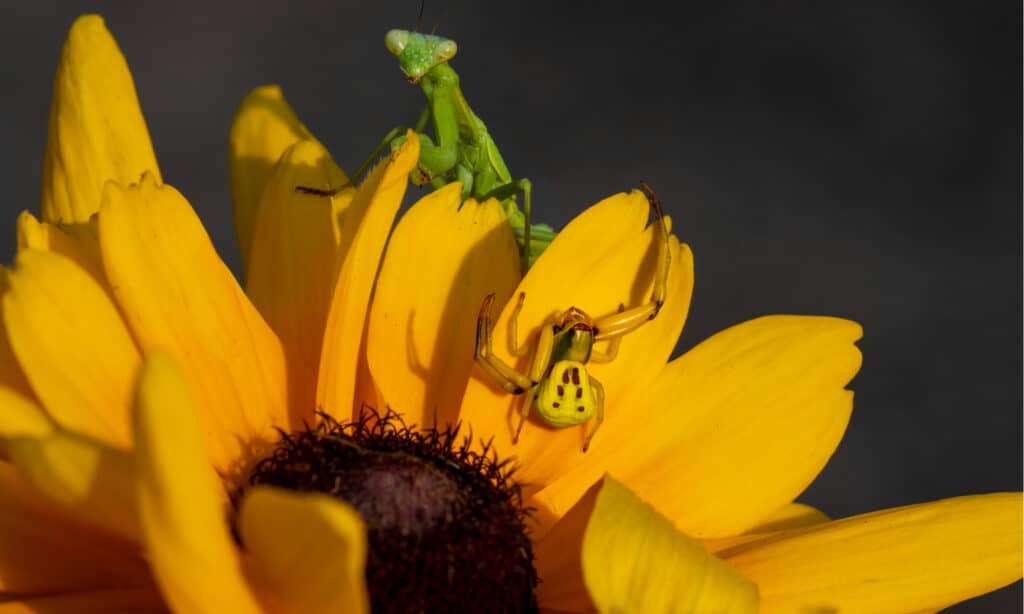
The white-banded crab spider waits inside flowers or on leaves and then grabs passing insects with its powerful front legs.
©Georgi Baird/Shutterstock.com
Misumenoides formosipes, or the white-banded crab spider, is a member of the crab spider family Thomisidae. You can find these spiders in Kentucky as well as throughout much of the United States.
Female white-banded crab spiders usually measure from 5 to 11 millimeters long and males measure 2.5 to 3.2 millimeters. They get their name from the white line running through the space below their eyes. Their color varies, but females typically appear white or yellow while males sport gold abdomens and dark brown legs and carapaces.
Like other crab spiders, they resemble crabs in terms of their appearance and habit of walking sideways and backward. They hunt by waiting inside flowers or on leaves for passing insects that they then grab with their powerful front legs. Their bite is not medically significant.
#5: Spintharus Flavidus
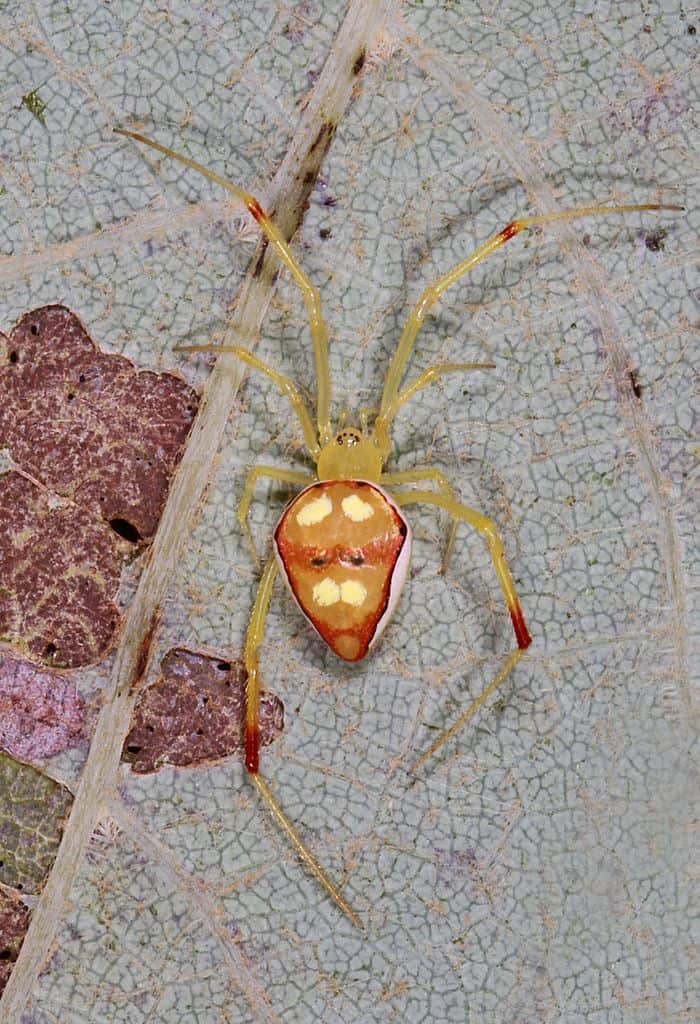
has yet to be given a common name. What name would you give this colorful spider?
©Judy Gallagher / Creative Commons – License
This next entry in our list of spiders in Kentucky is unique in that little is known about it. Spintharus flavidus is a small cobweb spider in the family Theridiidae. Its range extends down from the United States to parts of Bolivia and Brazil.
Most adult specimens are quite small. They typically measure only 4 to 5 millimeters long, with females measuring slightly larger than males. Without a doubt, their most striking feature is their coloration. They have bright orange abdomens with light orange markings and 4 cream-colored dots arranged in 2 rows of 2 dots each. Meanwhile, their legs and carapaces appear pale yellow and practically translucent.
To date, Spintharus flavidus lacks a common name and continues to go by its scientific classification. Little is known about its mating habits or method of prey capture. That said, based on its size, its bite is likely not medically significant.
#4. Difoliate Orb Weaver
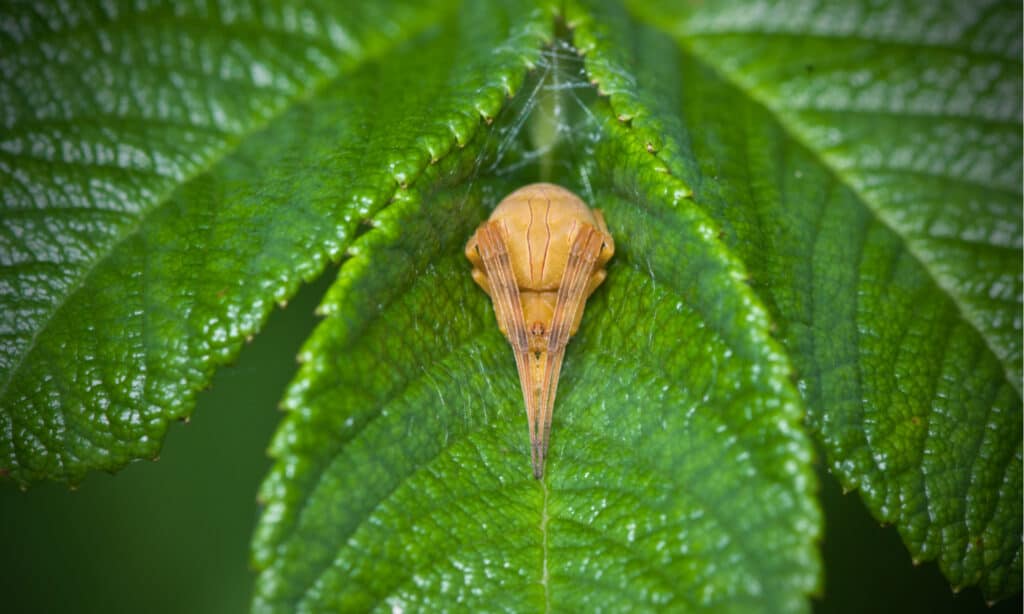
The difoliate orb weaver gets its name from the patterns on its abdomen that create two separate foliums or images.
©Gerry Bishop/Shutterstock.com
Acacesia hamata, or the difoliate orb weaver, is a member of the orb weaver family Araneidae. You can find these spiders in Kentucky as well as much of the eastern United States and as far south as Argentina. It is the only species in the genus Acacesia found in the United States.
Female difoliate orb weavers measure 4.7 to 9.1 millimeters long, while males measure 3.6 to 5 millimeters in length. They get their name from the dagger-like marking contained inside a wedge-shaped marking on their abdomens. This pattern creates two images or foliums. Meanwhile, the rest of their bodies appear greenish-grey to brown.
We know very little about the difoliate orb weaver’s biology and lifestyle. It tends to build its web in fields, prairies, and woodlands. While at rest, it has a habit of tucking its legs close to its body thereby creating a diamond shape.
#3. Canopy Jumping Spider
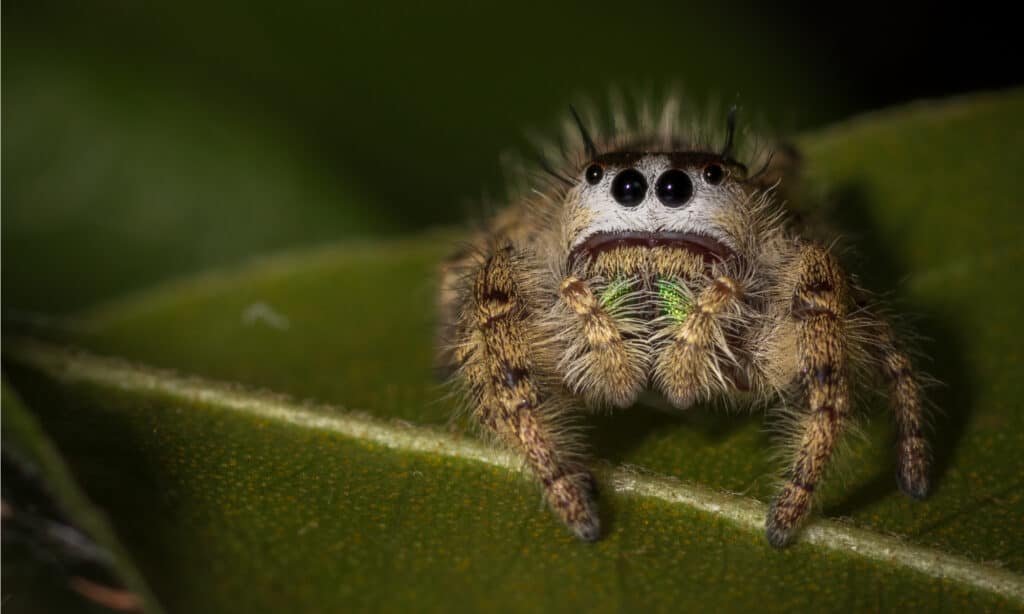
The canopy jumping spider is a tree-dwelling spider in the family Salticidae.
©OBX Wildlife/Shutterstock.com
The canopy jumping spider, Phidippus otiosus, is a member of the jumping spider family Salticidae. It ranges throughout the southeastern United States and spends most of its life in trees.
Female canopy jumping spiders can measure up to 16 millimeters long, with males typically measuring smaller than females. Black and orange hairs cover their bodies from their legs to their abdomens. One exception to this rule is the purplish-black marking located above their eyes. Additionally, they sport iridescent mouthparts that range in color from purple to green.
Canopy jumping spiders do not build webs to capture their prey. Instead, they actively stalk their prey and then leap from afar before delivering a killing blow with their fangs. They rarely act aggressively towards humans and their bite is not medically significant.
#2: Southeastern Wandering Spider
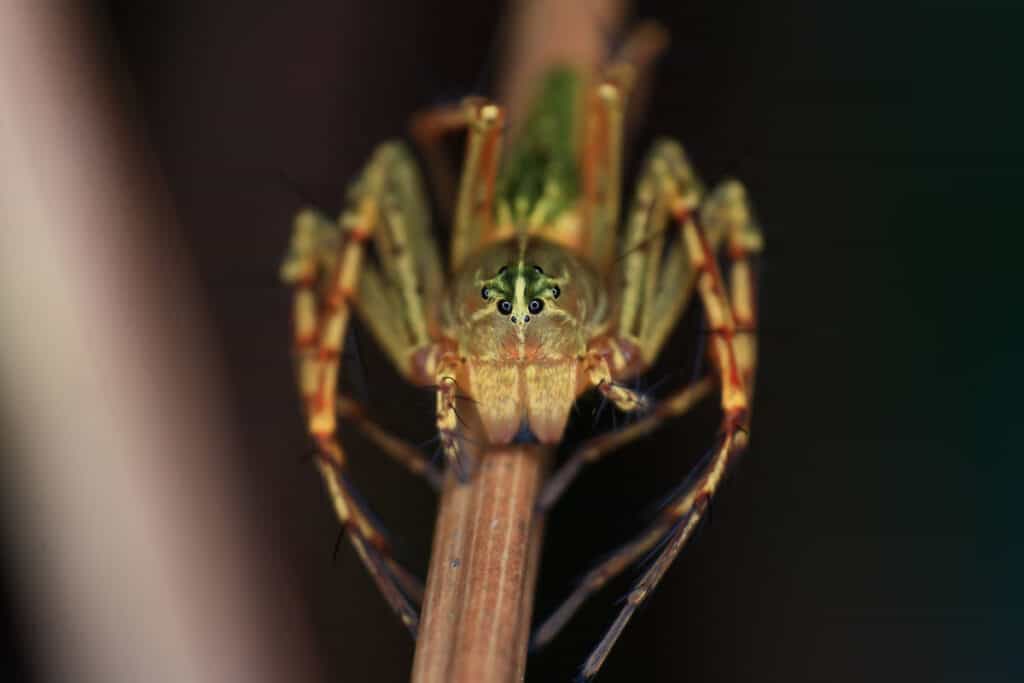
The southeastern wandering spider actively hunts for prey using ambush tactics.
©Firdaus Khaled/Shutterstock.com
The southeastern wandering spider, Anahita punctulata, belongs to the wandering spider family Ctenidae. You can find these spiders in Kentucky as well as throughout much of the southern United States.
Southeastern wandering spiders vary considerably in size, measuring anywhere from 5 to 40 millimeters long, with males measuring smaller than females. When active, they tend to curl their long, multi-jointed legs upward. Their bodies and legs appear predominantly tan or light orange with dark mottling. Meanwhile, they feature a light stripe down the center of their carapaces and abdomens.
As their name suggests, southeastern wandering spiders do not build webs to catch prey. On the contrary, they actively hunt prey using ambush tactics. When not hunting, they rest in burrows on the ground and on plants. Even though they are venomous, their bite poses no significant risk to humans.
#1. Northern Black Widow
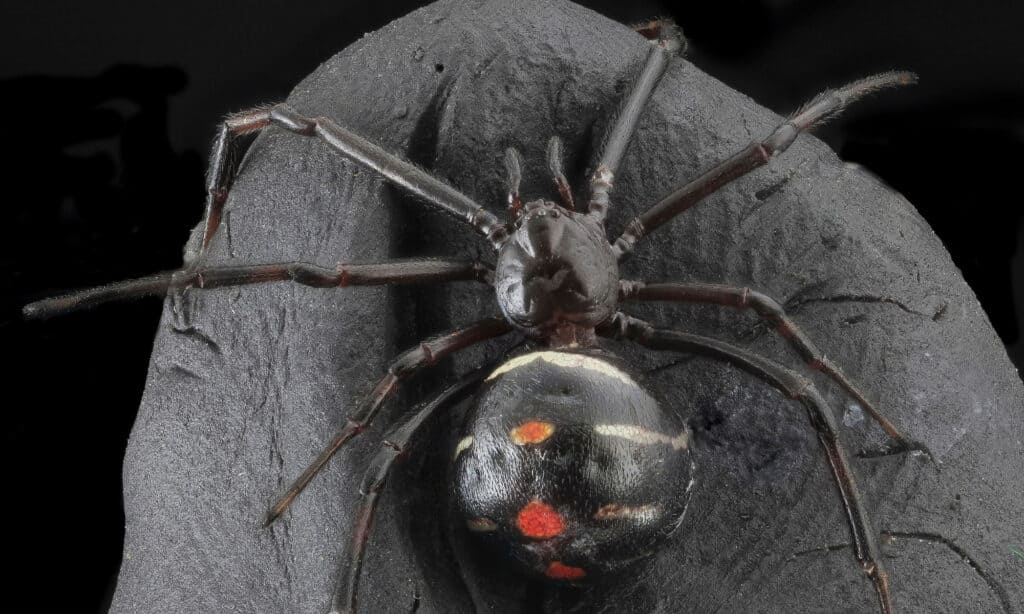
Unlike other black widows, northern black widows have a broken hourglass-shaped marking on their abdomens.
©Porco_Rosso/Shutterstock.com
Also known as the northern widow, the northern black widow, Latrodectus variolus, is one of the most venomous spiders in Kentucky. It belongs to the cobweb spider family Theridiidae and ranges throughout the eastern and northern United States along with southern Canada.
Female northern black widows measure from 9 to 11 millimeters long and males measure 4 to 5 millimeters long. Their bodies are almost entirely black except for a red hourglass-shaped marking on their abdomens. It’s worth noting that the hourglass usually appears broken. This enables you to differentiate them from southern black widows, which usually have an intact hourglass.
Northern black widows carry venom that can cause the illness latrodectism. Common symptoms from a black widow bite include pain, sweating, vomiting, muscle rigidity, and occasionally death. That said, deaths are rare and typically only occur if the person bit was especially young or immunocompromised.
Summary of 10 Spiders in Kentucky
Here’s a recap of 10 spiders found in Kentucky that we took a look at:
| Number | Spider | Scientific Name | Length |
|---|---|---|---|
| 1 | Northern Black Widow | Latrodectus variolus | Females: 9-11 mm; males: 4-5 mm |
| 2 | Southeastern Wandering Spider | Anahita punctulata | 5-40 mm |
| 3 | Canopy Jumping Spider | Phidippus otiosus | Females: up to 16 mm; males are smaller |
| 4 | Difoliate Orb Weaver | Acacesia hamata | Females: 4.7-9.1 mm; males: 3.6-5 mm |
| 5 | Spintharus Flavidus | Spintharus flavidus | 4-5 mm; females are larger than males |
| 6 | White-Banded Crab Spider | Misumenoides formosipes | Females: 5-11 mm; males: 2.5-3.2 mm |
| 7 | Rabid Wolf Spider | Rabidosa rabida | Females: nearly 25 mm; males are about half the size |
| 8 | Banded Garden Spider | Argiope trifasciata | Females: 13-15 mm; males are about one-third the size |
| 9 | Striped Fishing Spider | Dolomedes scriptus | Females: up to 25 mm; males are smaller |
| 10 | False Widow Spider | Steatoda grossa | Females: 6-11 mm; males are smaller |
The photo featured at the top of this post is © Ernie Cooper/Shutterstock.com
Thank you for reading! Have some feedback for us? Contact the AZ Animals editorial team.




